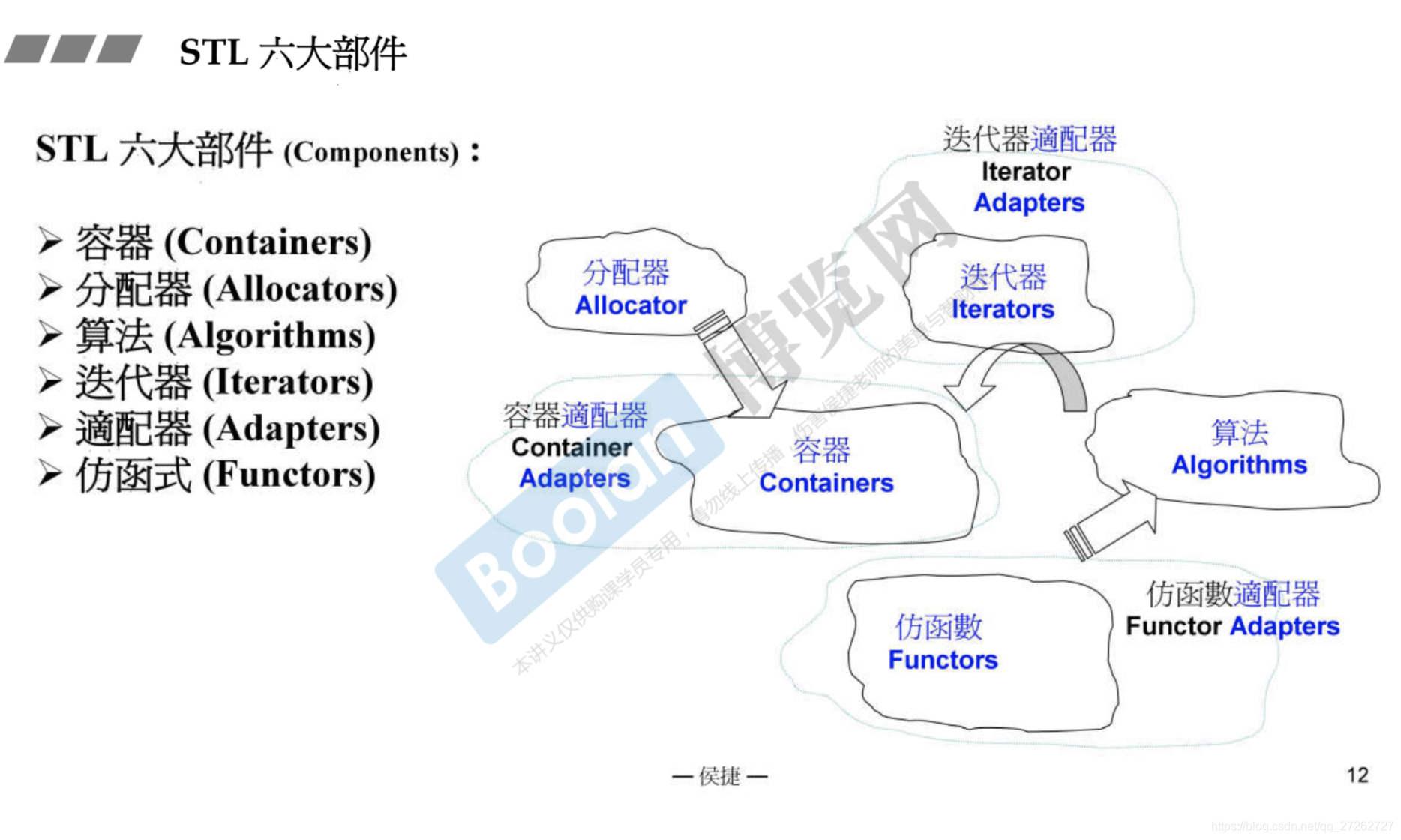目录
C++标准库

STL 六大部件
C++STL主要由6个组件(Components)组成,分别是:容器(Containers)、分配器(Allocators)、算法(Algorithms)、迭代器(Iterators)、适配器(Adapters)、仿函数(Functors)。最重要的:容器和算法。

下面介绍每个部件基本概念:
容器(Containers)是什么?可以理解为已经实现了的,功能完善的数据结构的集合,不同的容器对应着不同的数据结构,使用不同的容器就是在使用不同的数据结构。
分配器(Allocators)是C++STL中对内存进行分配和归还的工具。分配器(Allocators)表现出来的是特殊的内存模型(memory model),是一种用来把“内存需求”转化为“内存低级调用”的抽象层。最初是被用以处理各种指针(near,far,huge)的问题的抽象层(或者说是规范化的工具),现在在STL中被用以处理内存共享(shared memory)、垃圾回收(garbage collection)等。容器(Containers)对于分配器(Allocators)是有依赖的,容器(Containers)对象依赖于分配器(Allocators)进行内存的分配。
算法(Algorithms)中有很多算法的C++实现,大多以模板函数(Template Function)的形式存在,用以处理容器(Containers)中的数据。容器(Containers)中包含有对该容器(Containers)的一些基本操作,但更为复杂的处理就需要通过算法(Algorithms)中的各种算法(Algorithm)来实现。这里体现的是什么?不是OOP编程(面向对象编程),而是GP编程(模板编程)。使用GP编程的好处在于对算法的实现能够和单独的对象剥离开来,使得一套GP编程实现的算法(Algorithm)能够应用于多种容器(Containers)。
迭代器(Iterators)的用处在于辅助算法(Algorithms)对容器(Containers)中的数据(Data)进行处理。容器(Containers)中的数据往往不是只有单独的一条,而是大量数据的集合。而算法(Algorithms)在处理数据(Data)的时候,有时候需要面向容器(Containers)中的一个数据对象,有时候是多个,或者整体。对于这样子的需求,需要一个工具来帮助算法(Algorithms)来实现对容器(Containers)中数据的访问,而这个东西就是迭代器(Iterators)。
仿函数(Functors)是一些辅助算法(Algorithms)用于针对处理一些特殊数据对象的时候的一些自定义处理方式,用以增强算法(Algorithms)的处理能力。
适配器(Adapters)是处理一些兼容性所使用的工具。具体一点可以分为:容器适配器(Container Adapters)、迭代器适配器(Iterator Adapters)、仿函数适配器(Functors Adapters)。

code:
/*
在这个简单的代码示例中能看到有vector类型的容器对象vi,并且指定了一个allocator分配器,
且指定了分配的是int类型。这里需要注意的是一般可以不指定分配器,在不指定分配器的情况下会
使用默认的分配器,一但使用了分配器就必须保证分配器的类型参数是正确的。count_if是一种算
法,该算法的作用是在满足某种条件的情况下进行统计,vi.begin()和 vi.end()是两个Iterat
or类型的变量,用以标记count_if算法要处理的数据的范围。not1和bind2nd是仿函数适配器(It
erators Adapters),适配器bind2nd的作用就是绑定第二参数,也就是指定仿函数less的比较对
象。而not1这个适配器的作用是条件取反,也就是将适配器not1的对象的条件进行取反。less就是仿
函数(Functors)了。
*/
#include <vector>
#include <algorithm>
#include <functional>
#include <iostream>
using namespace std;
int main()
{
int ia[6] = {27, 210, 12, 47, 109, 83};
vector<int,allocator<int> > vi(ia, ia + 6);
cout << count_if(vi.begin(), vi.end(),
not1(bind2nd(less<int>(), 40))) << endl;
return 0;
}容器

for循环

auto

Reference






















 272
272











 被折叠的 条评论
为什么被折叠?
被折叠的 条评论
为什么被折叠?








